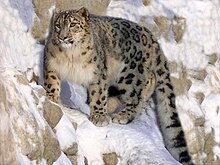| Snow leopard Temporal range:
| |
|---|---|

| |
| Scientific classification | |
| Domain: | Eukaryota |
| Kingdom: | Animalia |
| Phylum: | Chordata |
| Class: | Mammalia |
| Order: | Carnivora |
| Suborder: | Feliformia |
| Family: | Felidae |
| Subfamily: | Pantherinae |
| Genus: | Panthera |
| Species: | P. uncia
|
| Binomial name | |
| Panthera uncia (Schreber, 1775)
| |

| |
| Distribution of the snow leopard, 2017[1] | |
| Synonyms | |
The snow leopard (Panthera uncia) is a species of large cat in the genus Panthera of the family Felidae. The species is native to the mountain ranges of Central and South Asia. It is listed as Vulnerable on the IUCN Red List because the global population is estimated to number fewer than 10,000 mature individuals and is expected to decline about 10% by 2040. It is mainly threatened by poaching and habitat destruction following infrastructural developments. It inhabits alpine and subalpine zones at elevations of 3,000–4,500 m (9,800–14,800 ft), ranging from eastern Afghanistan, the Himalayas and the Tibetan Plateau to southern Siberia, Mongolia and western China. In the northern part of its range, it also lives at lower elevations.
Taxonomically, the snow leopard was long classified in the monotypic genus Uncia. Since phylogenetic studies revealed the relationships among Panthera species, it has since been considered a member of that genus. Two subspecies were described based on morphological differences, but genetic differences between the two have not yet been confirmed. It is therefore regarded as a monotypic species. The species is widely depicted in Kyrgyz culture.
- ^ a b c McCarthy, T.; Mallon, D.; Jackson, R.; Zahler, P. & McCarthy, K. (2017). "Panthera uncia". IUCN Red List of Threatened Species. 2017: e.T22732A50664030. doi:10.2305/IUCN.UK.2017-2.RLTS.T22732A50664030.en. Retrieved 19 November 2021.
